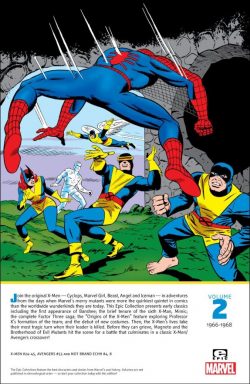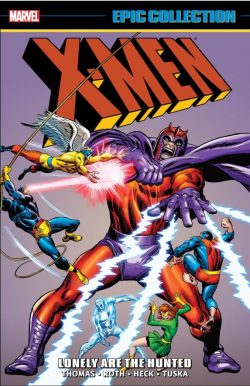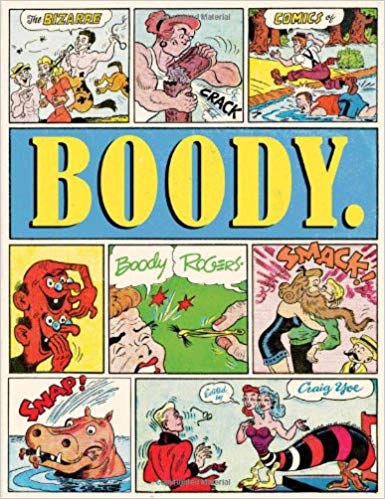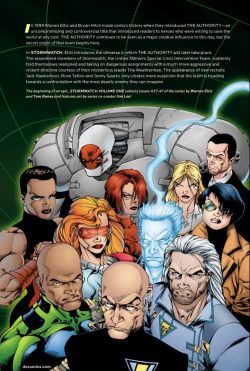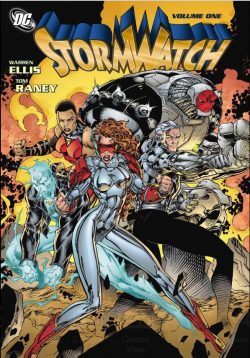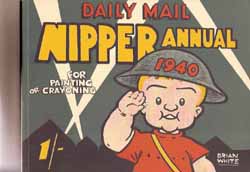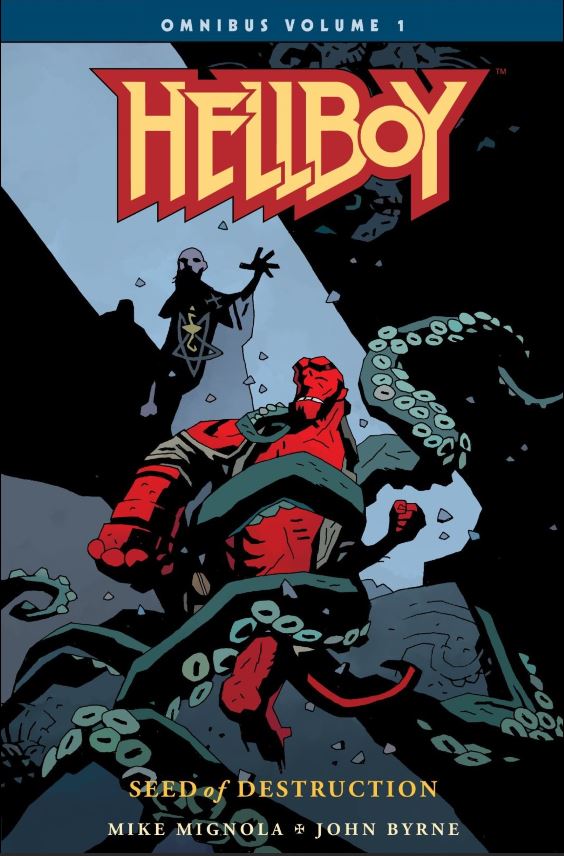
By Bob Haney, Gardner Fox, Ramona Fradon, Joe Orlando, Sal Trapani, Charles Paris & various (DC Comics)
ISBN: 978-1-4012-0762-5
By the time Metamorpho, the Element Man was introduced to the costumed hero-obsessed world the first vestiges of a certifiable boom were just becoming apparent. As such the light-hearted, almost absurdist take struck a Right-time, Right-place chord, blending far out adventure with tongue-in-cheek comedy.
The bold, brash Man of a Thousand Elements debuted in The Brave and the Bold #57 (December 1964/January 1965) and, after a follow-up try-out in the next issue, catapulted right into his own title for an eclectic and oddly engaging 17-issue run. Sadly, this canny monochrome compendium – collecting all those eccentric adventures plus team-up tales from B&B #66 and 68 and Justice League of America #42) – is currently the only archival collection available. Until someone rectifies that situation, at least you can revel in some truly enchanting black-&-white illustration…
Unlike most of these splendid Showcase editions, the team-up stories here are not re-presented in original publication order but closeted together at the back, so if stringent continuity is important to you, the always informative old-school credit-pages will enable you to navigate the wonderment in the correct sequence…
Sans dreary preamble the action commences with ‘The Origin of Metamorpho’ written by Bob Haney (who created the character and wrote everything here except the JLA story). The captivating art is by Ramona Fradon & Charles Paris and introduces glamorous he-man Soldier of Fortune Rex Mason, currently working as a globe-trotting artefact procurer and agent for ruthlessly acquisitive scientific genius/business tycoon Simon Stagg.
Mason is obnoxious and insolent but his biggest fault as far as his boss is concerned is that the mercenary dares to love and be loved by the millionaire’s only daughter Sapphire…
Determined to rid himself of the impudent Mason, Stagg dispatches his potential son-in-law to retrieve a fantastic artefact dubbed the Orb of Ra from the lost pyramid of Ahk-Ton in Egypt. The tomb raider is accompanied only by Java, a previously fossilised Neanderthal corpse Rex had discovered in a swamp and which (whom?) Stagg had subsequently restored to full life. Mason plans to take his final fabulous fee and whisk Sapphire away from her controlling father forever, but fate and his companion have other ideas…
Utterly faithful to the scientific wizard who was his saviour, Java sabotages the mission and leaves Mason to die in the tomb, victim of an ancient, glowing meteor. The man-brute rushes back to his master, carrying the Orb and fully expecting Stagg to honour his promise and give him Sapphire in marriage…
Trapped, knowing his time has come; Mason swallows a suicide pill as the scorching rays of the star-stone burn through him…
Instead of death relieving his torment Rex is mutated into a ghastly chemical freak capable of shape-shifting and transforming into any of the elements or compounds that comprised the human body: carbon, hydrogen, oxygen, calcium, iron, cobalt and so many others…
Hungry for vengeance, Mason follows and confronts his betrayers only to be overcome by the alien energies of the Orb of Ra. An uneasy détente is declared as Mason accepts Stagg’s desperate offer to cure him …“if possibleâ€.
The plutocrat is further horrified when Rex reveals his condition to Sapphire and finds she still loves him. Totally unaware of Stagg’s true depths of duplicity, Mason starts working for the tycoon as metahuman problem-solver Metamorpho, the Element Man.
Brave and the Bold #58 (February-March 1965) reveals more of Stagg’s closeted skeletons when old partner Maxwell Tremayne kidnaps the Element Man and later abducts Sapphire to his ‘The Junkyard of Doom!’ Apparently, the deranged armaments manufacturer was once intimately acquainted with the girl’s mother and never quite got over it…
The try-out comics were an unqualified success and Metamorpho promptly debuted in his own title, cover-dated July-August 1965, just as the wildly tongue-in-cheek “High Camp†craze was catching on in all areas of popular culture; blending ironic vaudevillian kitsch with classic movie premises as theatrical mad scientists and scurrilous spies began to appear everywhere.
‘Attack of the Atomic Avenger’ sees nuclear nut-job Kurt Vornak trying to crush Stagg Industries, only to be turned into a deadly, planet-busting radioactive super-atom, after which ‘Terror from the Telstar’ pits the charismatic cast against Nicholas Balkan, a ruthless criminal boss set on sabotaging America’s Space Program.
Mad multi-millionaire T.T. Trumbull then uses his own daughter Zelda to get to Simon Stagg through his heart, accidentally proving to everyone who knew him that the old goat actually has one. This was part of the maniac’s attempt to seize control of America in ‘Who Stole the U.S.A.?’, but the ambitious would-be despot backed up the scheme with an incredible robot specifically designed to destroy Metamorpho.
Happily, Rex Mason’s guts and ingenuity proved more effective than the Element Man’s astonishing powers…
America saved, the dysfunctional family head South of the Border, becoming embroiled in ‘The Awesome Escapades of the Abominable Playboy’ as Stagg tries to marry Sapphire off to Latino Lothario Cha Cha Chavez. The wilful girl is simply trying to make Mason jealous and had no idea of her dad’s true plans; Stagg senior has no conception of Chavez’s real intentions or connections to the local tin-pot dictator…
With this issue the gloriously stylish Ramona Fradon left the series, to be replaced by two artists who strove to emulate her unique, gently madcap manner of drawing with varying degrees of success. Luckily veteran inker Charles Paris stayed on to smooth out the rough edges…
First up was E.C. veteran Joe Orlando whose 2-issue tenure began with outrageous doppelganger drama ‘Will the Real Metamorpho Please Stand Up?’ wherein eccentric architect Edifice K. Bulwark tries to convince Mason to lend his abilities to his chemical skyscraper project. When Metamorpho declines Bulwark and Stagg attempt to create their own Element Man… with predictably disastrous consequences.
‘Never Bet Against an Element Man!’ (#6 May-June 1966) took the team to the French Riviera as gambling grandee Achille Le Heele snookers Stagg and wins “ownership†of Metamorpho. The Creepy Conchon’s ultimate goal necessitated stealing the world’s seven greatest wonders (such as the Taj Mahal and Eiffel Tower) and, somehow, only the Element Man can make that happen…
Sal Trapani took over pencilling with #7’s ‘Terror from Fahrenheit 5,000!’ as the acronymic super-spy fad hits hard. Metamorpho is enlisted by the C.I.A. to stop suicidal maniac Otto Von Stuttgart destroying the entire planet by dropping a nuke into the Earth’s core, before costumed villain Doc Dread is countered by an undercover Metamorpho becoming ‘Element Man, Public Enemy!’ in a diabolical caper of doom and double-cross…
Metamorpho #9 shifted into the realm of classic fantasy when suave and sinister despot El Mantanzas maroons the cast in ‘The Valley That Time Forgot!’: battling cavemen and antediluvian alien automatons, after which a new catalysing element is added in ‘The Sinister Snares of Stingaree!’
This yarn introduces Urania Blackwell – a secret agent somehow transformed into an Element Girl and sharing all Metamorpho’s incredible abilities. Not only is she dedicated to eradicating evil such as criminal cabal Cyclops, but Urania is also the perfect paramour for Rex Mason…
He even cancels his wedding to Sapphire to go gang-busting with her…
With a new frisson of sexual chemistry sizzling beneath the surface, ‘They Came from Beyond?’ finds the conflicted Element Man confronting an apparent alien invasion whilst ‘The Trap of the Test-Tube Terrors!’ provides another attempt to cure Rex of his unwanted powers. This allows mad scientist Franz Zorb access to Stagg Industry labs long enough to build an army of chemical horrors…
The plot thickens with Zorb’s theft of a Nucleonic Moleculizer, prompting a continuation in #14 wherein Urania is abducted only to triumphantly experience ‘The Return from Limbo’…
Events and stories grew increasingly outlandish and outrageous as the TV superhero craze intensified and ‘Enter the Thunderer!’ (#14, September/October 1967) depicted Rex pulled between Sapphire and Urania as marauding extraterrestrial Neutrog terrorises the planet in preparation for the awesome arrival of his mighty mutant master.
The next instalment heralded an ‘Hour of Armageddon!’ as the uniquely menacing Thunderer takes control of Earth until boy genius Billy Barton assists the Elemental defenders in defeating the mutant horror.
Trapani inked himself for Metamorpho #16; an homage to H. Rider Haggard’s She novels wherein ‘Jezeba, Queen of Fury!’ changes the Element Man’s life forever.
When Sapphire marries playboy Wally Bannister, the heartbroken Element Man undertakes a mission to find the lost city of Ma-Phoor. Here he encounters an undying beauty who wants to conquer the world and just happens to be Sapphire’s exact double.
Moreover, the immortal empress of a lost civilisation had once loved an Element Man of her own: a Roman soldier named Algon transformed into a chemical warrior two millennia previously.
Believing herself reunited with her lost love, Jezeba finally launches her long-delayed attack on the outside world with disastrous, tragic consequences…
The strangely appetising series came to a shuddering and unsatisfactory halt with the next issue as the superhero bubble burst and costumed comic characters suffered their second recession in fifteen years. Metamorpho was one of the first casualties, cancelled just as (or perhaps because) the series was emerging from its quirky comedic shell with the March-April 1968 issue.
Illustrated by Jack Sparling, ‘Last Mile for an Element Man!’ sees Mason tried and executed for the murder of Wally Bannister, resurrected by Urania Blackwell and set on the trail of true killer Algon. Along the way, Mason and Element Girl uncover a vast, incredible conspiracy and rededicate themselves to defending humanity at all costs.
The tale ends on a never-resolved cliffhanger: when Metamorpho was revived a few years later no mention was ever made of these last game-changing issues…
The elemental entertainment doesn’t end here though as this tome somewhat expiates the frustrating denouement with three terrific team-up tales beginning with The Brave and the Bold #66 (June/July 1966) and ‘Wreck the Renegade Robots’ where a mad scientist usurps control of the Metal Men just as their creator Will Magnus is preoccupied turning Metamorpho back into an ordinary mortal…
Two issues later (B& B #68 October/November 1966) the still Chemically Active Crime-buster battles Bat-Baddies Penguin, Joker and Riddler as well as a fearsomely mutated Caped Crusader in the thoroughly bizarre ‘Alias the Bat-Hulk!’ – both tales coming courtesy of Haney, Mike Sekowsky & Mike Esposito.
Sekowsky also drew the last story in this volume. Justice League of America #42 (February 1966) sees the hero joyfully join the World’s Greatest Superheroes to defeat a cosmic menace deemed The Unimaginable. The grateful champions instantly offer him membership but are astounded when – and why – ‘Metamorpho Says… No!’: a classic adventure written by Gardner Fox and inked by Bernard Sachs.
The wonderment finally concludes with a sterling pin-up of the Element Man and his core cast by Fradon & Paris.
Individually enticing, always exciting but oddly frustrating in total, this book will delight readers who aren’t too wedded to cloying continuity but simply seek a few moments of casual, fantastic escapism.
© 1965-1967, 2005 DC Comics. All Rights Reserved.


